高中英语牛津译林版模块7 Unit 4 Public transport Reading课件
文档属性
| 名称 | 高中英语牛津译林版模块7 Unit 4 Public transport Reading课件 | 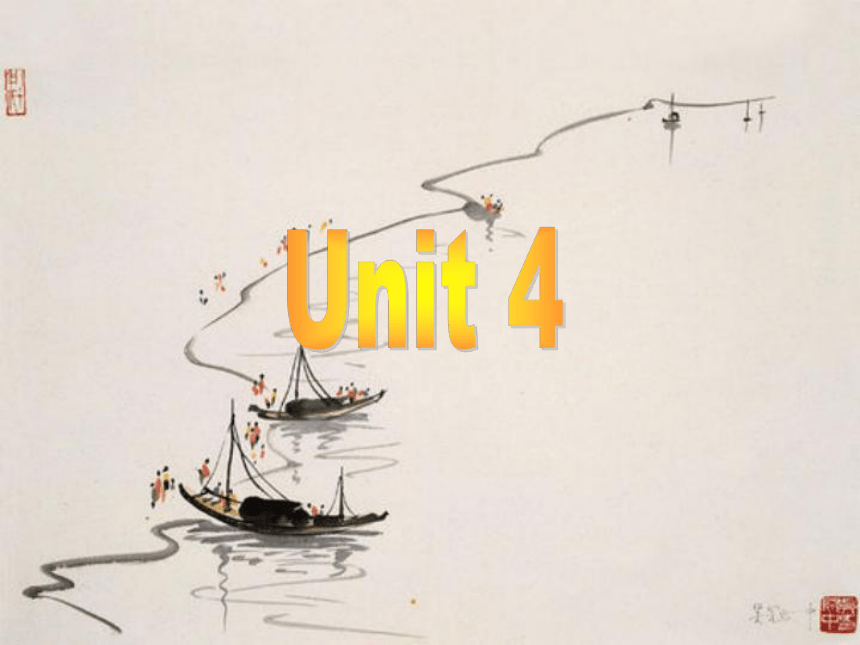 | |
| 格式 | zip | ||
| 文件大小 | 1.6MB | ||
| 资源类型 | 教案 | ||
| 版本资源 | 牛津译林版 | ||
| 科目 | 英语 | ||
| 更新时间 | 2016-05-12 07:58:37 | ||
图片预览

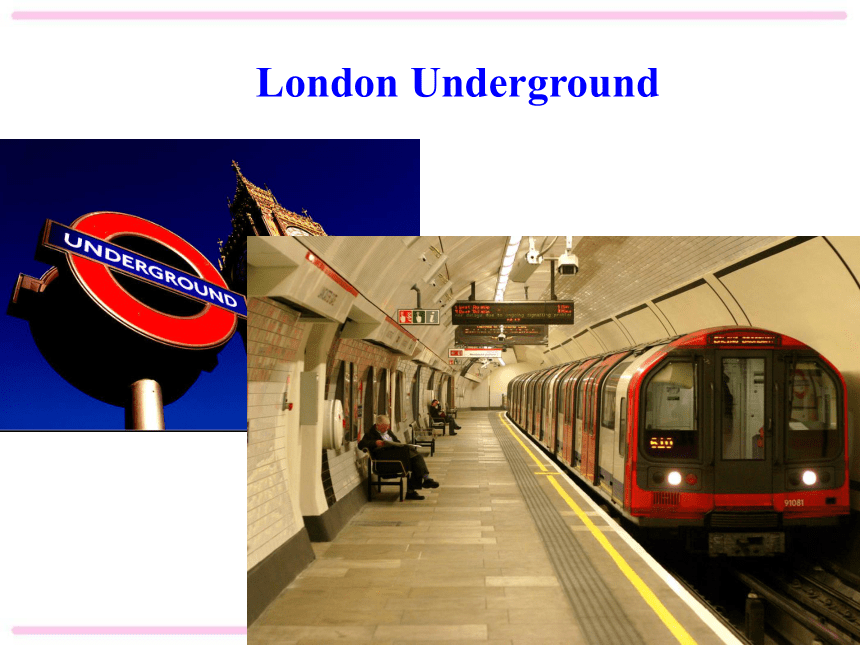
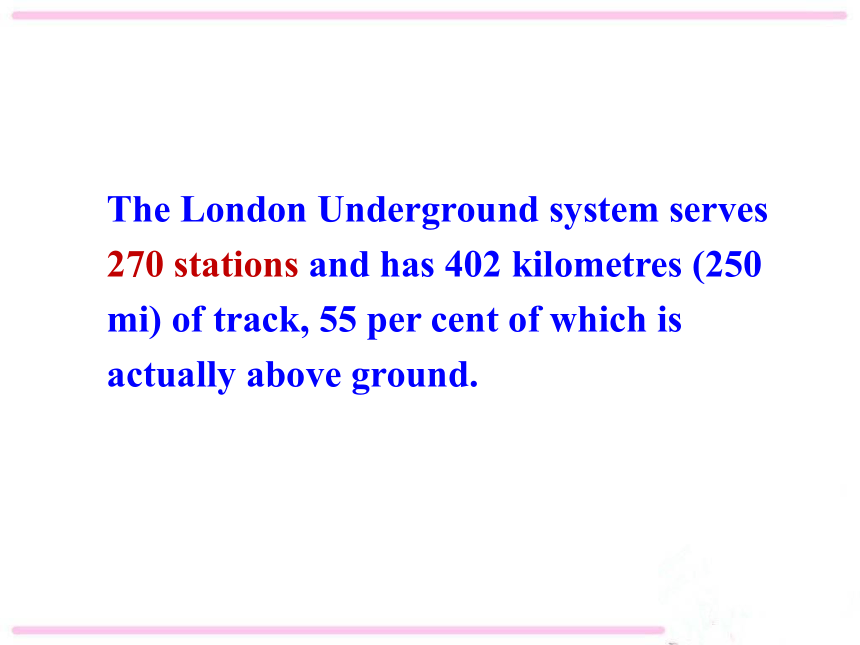
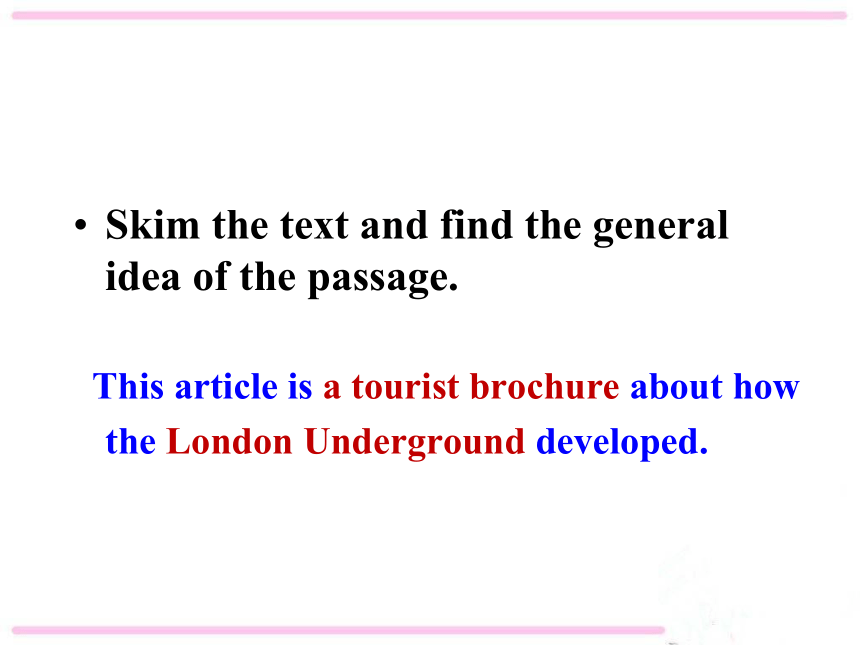
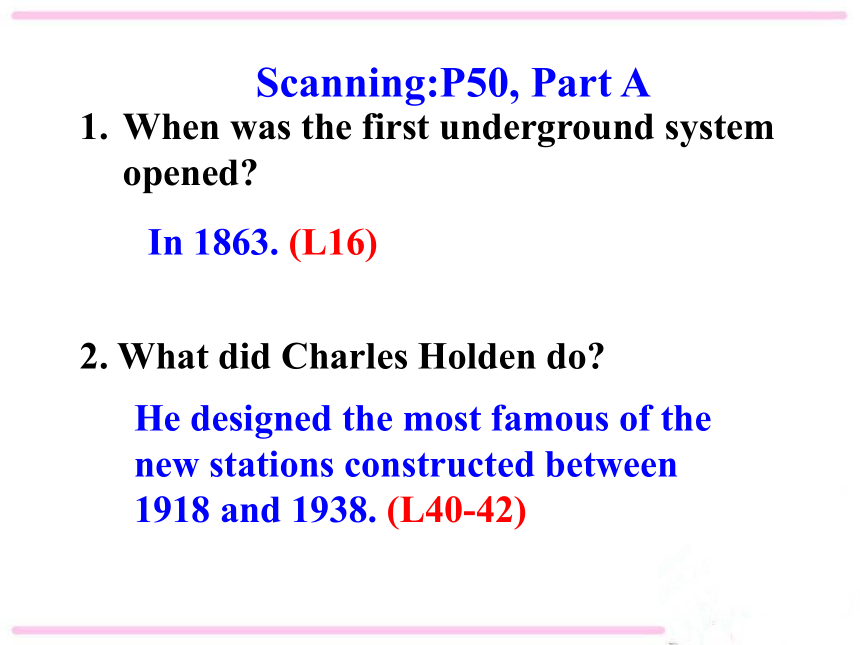
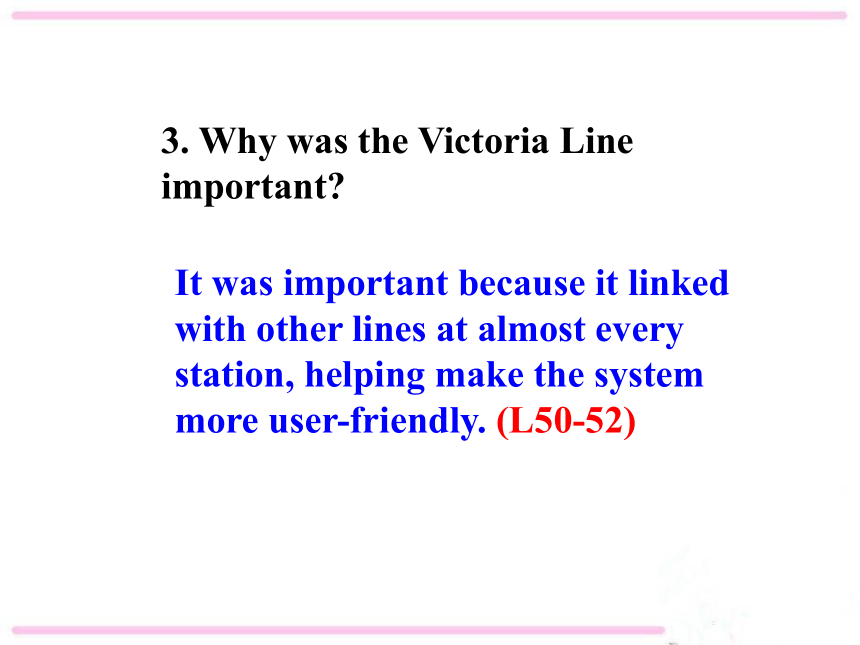

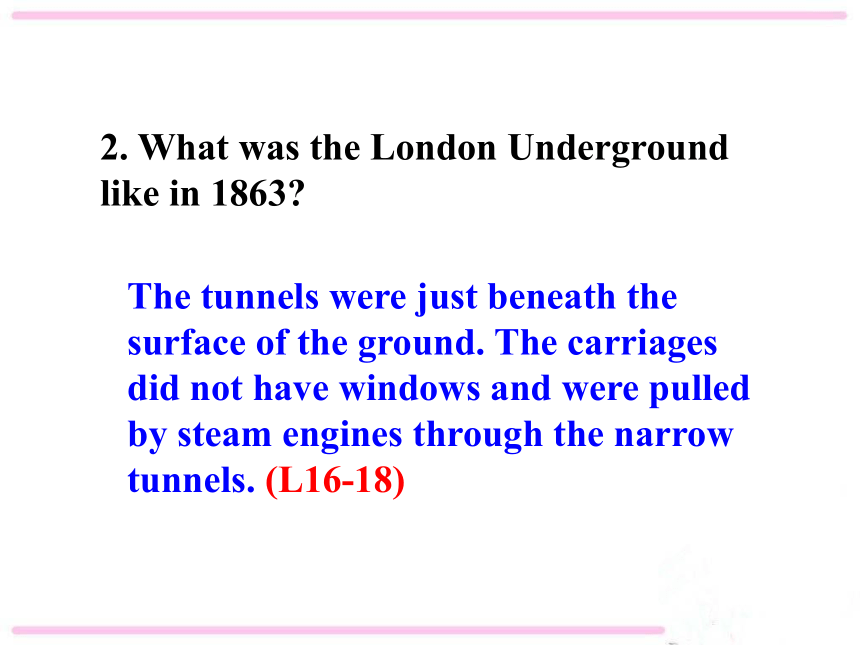
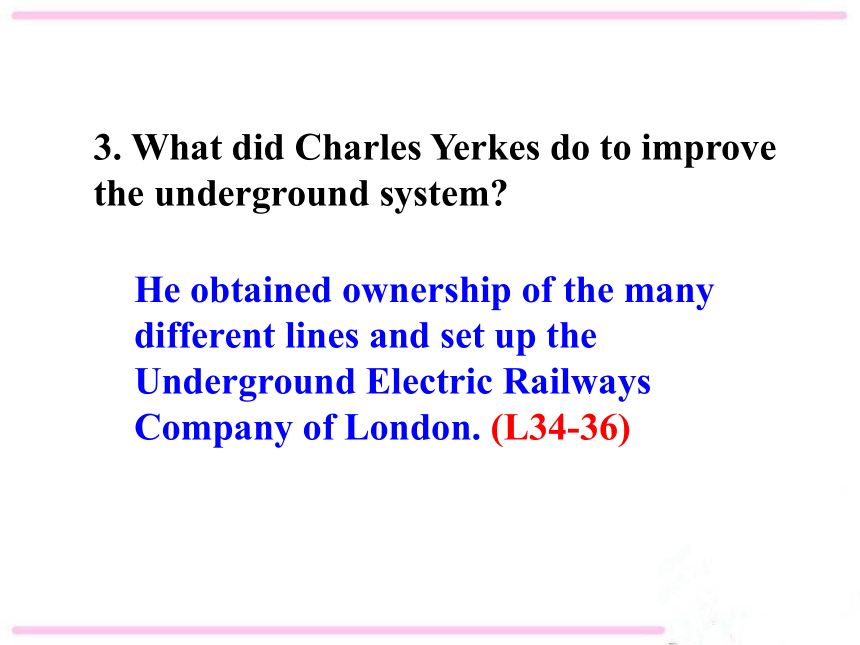
文档简介
课件28张PPT。Unit 4 London UndergroundThe London Underground system serves 270 stations and has 402 kilometres (250 mi) of track, 55 per cent of which is actually above ground.Skim the text and find the general idea of the passage.
This article is a tourist brochure about how the London Underground developed. When was the first underground system opened?
2. What did Charles Holden do?
In 1863. (L16)He designed the most famous of the new stations constructed between 1918 and 1938. (L40-42)
Scanning:P50, Part AIt was important because it linked with other lines at almost every station, helping make the system more user-friendly. (L50-52)
3. Why was the Victoria Line important?1. Why was the underground system developed in London?Most railway tracks did not go into the London city centre, so buses, trams, cabs, and carriages were required. The number of vehicles on the road caused unbelievable traffic jams. So the underground system was developed in London. (L4-9)
Read again and answer the following questions.(P52, Part C1)2. What was the London Underground like in 1863?The tunnels were just beneath the surface of the ground. The carriages did not have windows and were pulled by steam engines through the narrow tunnels. (L16-18)
3. What did Charles Yerkes do to improve the underground system?He obtained ownership of the many different lines and set up the Underground Electric Railways Company of London. (L34-36)
4. What unusual uses did the tube have during World War II ?During World War II, the tube was used as a bomb shelter, an airplane factory, a centre for directing the defence against air attacks and meeting rooms for the government administration. (L44-48)
5. What happened to the London Underground after World War II?After World War II, the underground system was enlarged and more lines were added because more people travelled on the underground. (L50)
6. What does it mean when the brochure says that the underground system is user-friendly?It means that it is very convenient for passengers to go to different places in the city from any station. (L16)
Underline the time clues in the text quickly. Remember the details of each time clue as quickly as you can. (P52, Part C2)An underground railway was approved to be built by the British government.(L11)The first tunnels were opened. (L16)The next section of the underground system was opened in the south of London. (L18)
Development of the LU system.Two companies linked up to provide underground service in the middle of the city. The first railway tunnel under the River Thames was dug. (L20, 27)
The first electric underground railway was opened. (L29)The London Passenger Transport Board was created. (L36)Many new stations were constructed. (L40)
The Jubilee Line was opened. (L53)Paragraph 1Paragraphs 2-4Paragraph 5Paragraphs 6-7The main ideas of the four partsThe main ideas of the four partsPart 1:Paragraph 1
____________why the first underground system in the world was developed.
Part 2: Paragraphs 2-4
____________of the underground system before World War II.ReasonsDevelopmentsPart 3:Paragraph 5
Some _____________of the underground system during World WarⅡ.
Part 4: Paragraphs 6-7
Expansion and popularity of the first underground system. unusual usesWhat are the main features of a brochure about a place of interest?Discussion 1. A brief history of development---in time order2. Important people3. Interesting facts eg. The unusual uses during WWⅡ4. Encourage you to visitHOMEWORK:1. P125, PartA1 and A22. Preview the language focusCharles Henry HoldenCharles Henry Holden (1875 –1960) was a Bolton-born English architect best known for designing many London Underground stations during the 1920s and 1930s, for Bristol Central Library, the Underground Electric Railways Company of London's headquarters at 55 Broadway and for the University of London's Senate House. 55 Broadway is a listed building overlooking
St. James's Park in LondonSouth Wimbledon station, one of the stations for the
extension of the City and South London RailwaySubway Town StationArnos Grove StationSouthgate Station
This article is a tourist brochure about how the London Underground developed. When was the first underground system opened?
2. What did Charles Holden do?
In 1863. (L16)He designed the most famous of the new stations constructed between 1918 and 1938. (L40-42)
Scanning:P50, Part AIt was important because it linked with other lines at almost every station, helping make the system more user-friendly. (L50-52)
3. Why was the Victoria Line important?1. Why was the underground system developed in London?Most railway tracks did not go into the London city centre, so buses, trams, cabs, and carriages were required. The number of vehicles on the road caused unbelievable traffic jams. So the underground system was developed in London. (L4-9)
Read again and answer the following questions.(P52, Part C1)2. What was the London Underground like in 1863?The tunnels were just beneath the surface of the ground. The carriages did not have windows and were pulled by steam engines through the narrow tunnels. (L16-18)
3. What did Charles Yerkes do to improve the underground system?He obtained ownership of the many different lines and set up the Underground Electric Railways Company of London. (L34-36)
4. What unusual uses did the tube have during World War II ?During World War II, the tube was used as a bomb shelter, an airplane factory, a centre for directing the defence against air attacks and meeting rooms for the government administration. (L44-48)
5. What happened to the London Underground after World War II?After World War II, the underground system was enlarged and more lines were added because more people travelled on the underground. (L50)
6. What does it mean when the brochure says that the underground system is user-friendly?It means that it is very convenient for passengers to go to different places in the city from any station. (L16)
Underline the time clues in the text quickly. Remember the details of each time clue as quickly as you can. (P52, Part C2)An underground railway was approved to be built by the British government.(L11)The first tunnels were opened. (L16)The next section of the underground system was opened in the south of London. (L18)
Development of the LU system.Two companies linked up to provide underground service in the middle of the city. The first railway tunnel under the River Thames was dug. (L20, 27)
The first electric underground railway was opened. (L29)The London Passenger Transport Board was created. (L36)Many new stations were constructed. (L40)
The Jubilee Line was opened. (L53)Paragraph 1Paragraphs 2-4Paragraph 5Paragraphs 6-7The main ideas of the four partsThe main ideas of the four partsPart 1:Paragraph 1
____________why the first underground system in the world was developed.
Part 2: Paragraphs 2-4
____________of the underground system before World War II.ReasonsDevelopmentsPart 3:Paragraph 5
Some _____________of the underground system during World WarⅡ.
Part 4: Paragraphs 6-7
Expansion and popularity of the first underground system. unusual usesWhat are the main features of a brochure about a place of interest?Discussion 1. A brief history of development---in time order2. Important people3. Interesting facts eg. The unusual uses during WWⅡ4. Encourage you to visitHOMEWORK:1. P125, PartA1 and A22. Preview the language focusCharles Henry HoldenCharles Henry Holden (1875 –1960) was a Bolton-born English architect best known for designing many London Underground stations during the 1920s and 1930s, for Bristol Central Library, the Underground Electric Railways Company of London's headquarters at 55 Broadway and for the University of London's Senate House. 55 Broadway is a listed building overlooking
St. James's Park in LondonSouth Wimbledon station, one of the stations for the
extension of the City and South London RailwaySubway Town StationArnos Grove StationSouthgate Station
